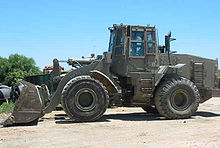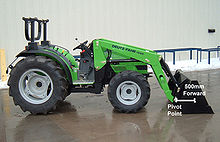- Loader (equipment)
-
This article is about the piece of construction equipment. For the Australian rock band, see Front End Loader.
A loader is a heavy equipment machine often used in construction, primarily used to load material (such as asphalt, demolition debris, dirt, snow, feed, gravel, logs, raw minerals, recycled material, rock, sand, and woodchips) into or onto another type of machinery (such as a dump truck, conveyor belt, feed-hopper, or railcar).
Contents
Heavy equipment front loaders
 Loader removing snow in Jyväskylä, Finland.
Loader removing snow in Jyväskylä, Finland.
A loader (also known as: bucket loader, front loader, front end loader, payloader, scoop loader, shovel, skip loader, and/or wheel loader) is a type of tractor, usually wheeled, sometimes on tracks, that has a front mounted square wide bucket connected to the end of two booms (arms) to scoop up loose material from the ground, such as dirt, sand or gravel, and move it from one place to another without pushing the material across the ground. A loader is commonly used to move a stockpiled material from ground level and deposit it into an awaiting dump truck or into an open trench excavation.
The loader assembly may be a removable attachment or permanently mounted. Often the bucket can be replaced with other devices or tools—for example, many can mount forks to lift heavy pallets or shipping containers, and a hydraulically-opening "clamshell" bucket allows a loader to act as a light dozer or scraper. The bucket can also be augmented with devices like a bale grappler for handling large bales of hay or straw.
Large loaders, such as the Kawasaki 95ZV-2, John Deere 844K, Caterpillar 950H, Volvo L120E, Case 921E, or Hitachi ZW310 usually have only a front bucket and are called Front Loaders, whereas small loader tractors are often also equipped with a small backhoe and are called backhoe loaders or loader backhoes or JCBs, after the company that first invented them.
The largest loader in the world is LeTourneau L-2350. Currently these large loaders are in production in the Longview, Texas facility. The L-2350 uses a diesel electric propulsion system similar to that used in a locomotive. Each rubber tired wheel is driven by its own independent electric motor.
Loaders are used mainly for uploading materials into trucks, laying pipe, clearing rubble, and digging. A loader is not the most efficient machine for digging as it cannot dig very deep below the level of its wheels, like a backhoe can. The capacity of a loader bucket can be anywhere from 0.5 to 36 m³ [1] depending upon the size of the machine and its application. The front loader's bucket capacity is generally much bigger than a bucket capacity of a backhoe loader.
Unlike most bulldozers, most loaders are wheeled and not tracked, although track loaders are common. They are successful where sharp edged materials in construction debris would damage rubber wheels, or where the ground is soft and muddy. Wheels provide better mobility and speed and do not damage paved roads as much as tracks, but provide less traction.
In construction areas loaders are also used to transport building materials - such as bricks, pipe, metal bars, and digging tools - over short distances.
Front loaders are commonly used to remove snow especially from sidewalks, parking lots, and other areas too small for using snowplows and other heavy equipment. They are sometimes used as snowplows with a snowplow attachment but commonly have a bucket or snowbasket, which can also be used to load snow into the rear compartment of a snowplow or dump truck.
High-tip buckets are suitable for light materials such as chip, peat and light gravel and when the bucket is emptied from a height.
Unlike backhoes or standard tractors fitted with a front bucket, many large loaders do not use automotive steering mechanisms. Instead, they steer by a hydraulically actuated pivot point set exactly between the front and rear axles. This is referred to as "articulated steering" and allows the front axle to be solid, allowing it to carry greater weight. Articulated steering provides better maneuverability for a given wheelbase. Since the front wheels and attachment rotate on the same axis, the operator is able to "steer" his load in an arc after positioning the machine, which can be useful. The tradeoff is that when the machine is "twisted" to one side and a heavy load is lifted high, it has a greater risk of turning over to the "wide" side.
Front loaders gained popularity during the last two decades, especially in urban engineering projects and small earthmoving works. Heavy equipment manufacturers offer a wide range of loader sizes and duties.
The term "loader" is also used in the debris removal field to describe the boom on a grapple truck.
Armored Wheel Loaders
The Israeli Combat Engineering Corps use armored Caterpillar 966 wheel loader for construction and combat engineering missions in hostile territories such as the West Bank. They are often seen building or removing road blocks, building bases and fortifications and starting in 2005, demolishing small houses. The IDF added armor plating for the loader, protecting it against rocks, stones, molotov cocktails, and light gunfire.
Rio de Janeiro's police elite squad BOPE have recently acquired one wheel loader of military purposes to open routes and make way for the police in Rio de Janeiro's slums, which are controlled, and blocked, by drugdealers.[2] It is nicknamed "The Skulls' Transformer", being a reference to how they call themselves -- "The Skulls".
Tractor front loaders
These loaders are a popular addition to tractors from 50 to 200 hp. Its current 'drive-in' form was originally designed and developed in 1958 by a company called Quicke [3] They were developed to perform a multitude of farming tasks, and are popular due to their relatively low cost (compared to Telehandler) and high versatility. Tractor loaders can be fitted with many attachments such as hydraulic grabs and spikes to assist with bale and silage handling, forks for pallet work, and buckets for more general farm activities.
Compact front end loaders
Popular additions to compact utility tractors and farm tractors are Front End Loaders, also referred to as a FEL. Compact utility tractors, also called CUTs are small tractors, typically with 18 to 50 horsepower (37 kW) and used primarily for grounds maintenance and landscape chores. There are 2 primary designs of compact tractor FELs, the traditional dogleg designed style and the curved arm style.
John Deere Tractor manufactures a semi-curved loader design that does not feature the one piece curved arm, but also is not of the traditional two piece design. New Holland Ag introduced a compact loader with a one piece curved arm on its compact utility tractors, similar one piece curved arm loaders are now available on compact tractors on many brands including Case/Farmall, and some Montana and Kioti tractors. Kubota markets traditional loader designs on most of its compact tractors but now features a semi-curved loader design similar to the John Deere loader design on several of its small tractors.
While the Front End Loaders on CUT size tractors are capable of many tasks, given their relatively small size and low capacities when compared to commercial loaders, the compact loaders can be made more useful with some simple options. A Toothbar is commonly added to the front edge of a loader bucket to aid with digging. Some loaders are equipped with a quick coupler, otherwise known as a Quick Attach (QA) system, the QA system allows the bucket to be removed easily and other tools to be added in its place. Common additions would include a set of Pallet Forks for lifting pallets of goods or a Bale Spear for lifting hay bales.
Skid loaders & track loaders
Main articles: skid loader and track loaderA skid loader is a small loader utilizing four wheels with hydraulic drive that directs power to either, or both, sides of the vehicle. Very similar in appearance and design is the track loader, which utilizes a continuous track on either side of the vehicle instead of the wheels. Since the expiration of Bobcat's patent on its quick-connect system, newer tractor models are standardizing on that popular format for front end attachments.
Swingloaders
A swing loader is a rigid frame loader with a swinging boom. The boom can swing 180 degrees or more. Swingloaders are primarily used by the railroad industry to lay rail. Like other loaders many attachments can be attached to the boom such as magnets, forks, and buckets. Smaller swingloaders are used in farming applications for loading out. A swinging boom is advantageous where space is limited. The loader is able to lift on all sides and dump off on all sides.
Gallery
-
A Hanomag loader
-
A Caterpillar 930G fitted with a loader rake on a residential construction site in South Florida.
-
The front of a Caterpillar 930G fitted with loader rake.
See also
- Backhoe loader
- Bulldozer
- Compactor
- Crane
- Excavator
- Grader
- Skid loader
- Tractor
- Telescopic handler
- Mining Simulation
Notable manufacturers
- Bobcat Company
- Case
- Caterpillar
- JCB
- John Deere
- Kawasaki
- Komatsu
- Kubota
- Manitou
- LeTourneau
- Liebherr
- LiuGong
- New Holland
- Volvo Construction Equipment
- Wacker Neuson
References
- ^ http://www.cat.com/cda/layout?m=308907&x=7
- ^ http://noticias.uol.com.br/cotidiano/2009/08/12/ult5772u4933.jhtm
- ^ http://www.quicke.nu/default.asp?id=1391 A history of Quicke loader development
External links
Categories:- Engineering vehicles
- Agricultural machinery
- Snow removal
- Construction equipment
-
Wikimedia Foundation. 2010.














